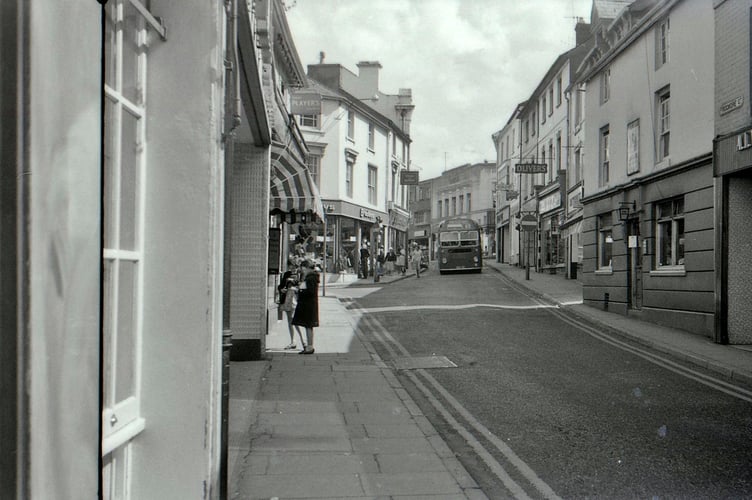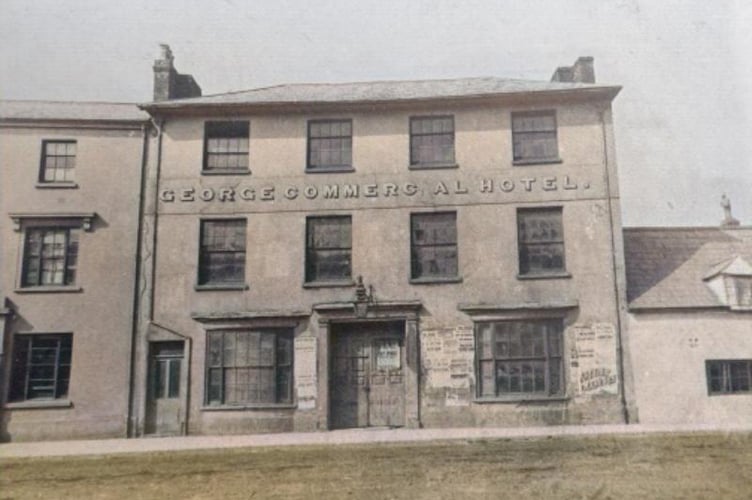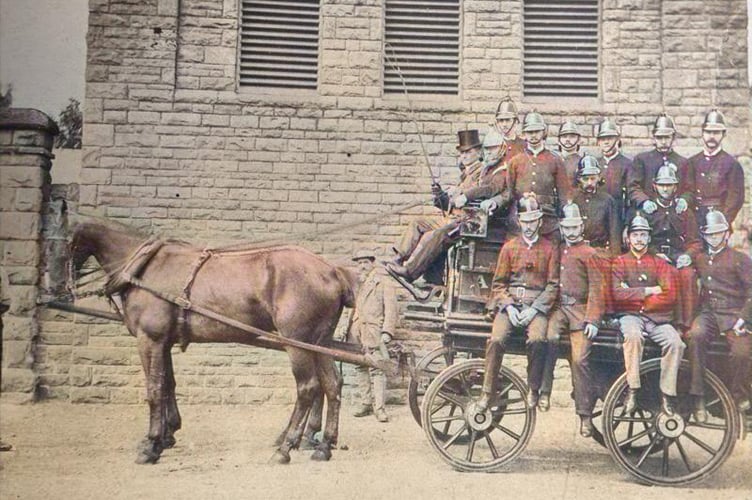THE inferno that erupted in Frogmore Street earlier this month was so unexpected, so destructive and so determined to burn through the night and into the next day, that you might be fooled into thinking that the fire was simply a one-off.
Surely such a little street in a little town like Abergavenny could only be reduced to ashes once?
Unfortunately, that’s not quite correct. History shows that sections of this old and vibrant street have fallen to the flames on at least two other occasions.
The most recent was in December 1939.

It was only a few short months after Britain had declared war on Germany. The Blitz, which would begin on September 7, 1940, was still a nightmare that had yet to happen.
However, for Abergavenny, fire, burnt-out buildings, a smoke-laden breeze and a sun rising on the ashes of what once was would come early.
The blaze would start, as so many do, accidentally, in a fish and chip shop where tragically there was plenty of fuel to feed the fire.
Local man David Evans told The Chronicle, “I was in the early hours of Sunday morning on December 17 when it happened. It started in the fish and chip shop but spread to my father’s shop which was F. Evans Butchers (40 Frogmore Street).”
The two shops stood side-by-side and were next to the pub, The Butchers' Arms (42 Frogmore Street) which was one of the town’s oldest public houses and where the Abergavenny Society for the Prosecution of Felons would get together over an ale or two in the 19th Century.
The Butcher’s Arms was situated next to what is now the Italian Restaurant II Gusto (43 Frogmore Street.)
In 1834, 43 Frogmore Street was listed as being home to the George Inn. At the turn of the 20th Century, a part of the building was a studio for double National Eisteddfod winner and photographer Eddie Madge, who took many pictures of old Abergavenny before he emigrated to the USA. The other part was used as a furniture shop owned by Mr. C. Downes
David explained, “My father’s butchers and the fish and chip shop were completely destroyed by the blaze and it also damaged a large part of the roof of the Butcher’s Arms, much like what happened to Cable News in the most recent fire.
“No one’s sure how it really started but once the fish and chip shop went up and the fire made its way into the cooking fat it spread very quickly. Apparently, it was a very windy night and that helped to fan the flames. Onlookers described how they could see the flames flickering across the war monument it was that bad.”

The fire service, like they did with the most recent inferno, did extremely well to contain it.
A report in the December 22, 1939 edition of The Abergavenny Chronicle reads,
"While Abergavenny was sleeping early on Sunday morning one of the fiercest fires that has occurred locally within living memory broke out in Frogmore Street and before it could be extinguished two lock-up shops were completely gutted.
The fire must have been smouldering for some considerable time before it assumed serious proportions. Half an hour before the outbreak was first observed a police constable had passed by and observed nothing unusual."
The fire was first noticed by a man named Sullivan at 5.30 pm who was on his way to work at the nearby gasworks. He sounded the alarm and police officers arrived on the scene at about the same time residents were awoken by the glare and crackling of the flames.

The report continues, "The fire brigade received the call about a quarter to six and when they arrived they found the premises like a furnace. One of the firemen dashing to the Fire Station had to go to the other side of the Monument owing to the intense heat.
The fire was worst at the fish and chip shop where a quantity of fat fed the devouring flames. One of the early arrivals on the scene described the spectacle as frightening. Aided by the wind, tongues of flame leapt halfway across the street and the flames seemed to reach as high as the Baptist Church. For miles in the country the glare in the sky was clearly visible.
Soon the two shops were an inferno of fire, and flames made an inroad on the roof of the Butchers' Arms inn adjoining. It seemed that nothing could save this old and well-timbered building and spectators had a real fear that the furniture emporium of Mr. C. Downes adjoining, would be involved and the the fire would spread to Baker Street before it could be checked.
The wind occasionally drove the flames to the rear, and premises in the Prince's Street seemed to be in grave danger.
Lieut F.J Parry, who had many years experience of fire fighting, expressed the opinion that it was an even fiercer fire that that at the Eureka Restaurant in Cross Street many years ago.
On their arrival, the brigade could not approach very near the blaze owing to the overpowering heat. They got to work promptly and with two jets soon had a plentiful supply of water playing on the flames. After working arduously for an hour and a half they managed to get the fire under control, but it was about four hours before they were able to leave the premises.
When they had cooled the fire down sufficiently, firemen clambered on the roofs and concentrated on preventing the fire encroaching further in the Butchers' Arms. They did good work in saving these premises, though a good deal of damage was done to the interior owing to the amount of water which had to be poured on the roof."
Once the fire had been put out, it quickly became apparent that the two shops were burnt beyond salvaging but the Butchers’ Arms could be repaired.

David explained, “The fish and chip shop and my father’s butchers had to be demolished. It came at a bad time for him because he was due to married in two weeks, but there was a war on so you didn’t moan. He just moved his business further up Frogmore Street to where the Air Ambulance Shop is now and got on with it.”
Although the Chronicle reported that all that remained of Mr Evans's takings for that week was a number of badly burnt coins and a brace of peasants "cooked before their time" he was at least insured, sadly, Mr Carpenter was not.
It's also interesting to note that a Captain H.C. Powell who had over 50 years service as a firefighter when the fire broke out, insisted on turning up at the scene and lending a helping hand. Yet it proved a little too much for the old timer's advanced years and he was taken ill and returned home to receive medical attention.
In one of those peculiar twists of fate, because he was too old to be enrolled in the army, Francis Evans would be later called up to join the National Fire Service for the duration of the Second World War.
After the demolition, the empty space where once two popular businesses had been was a constant reminder of the damage that fire, perhaps the most volatile and vicious element, can inflict in such a short space of time.

As David explained, “There was a gap between the Butcher’s Arms and the houses on Frogmore Street until they began to build the new flats. For years it was like a wasteland that people used to park their cars in, that sort of thing. It’s funny to look around and think how much this town has changed in my lifetime and how much it will continue to change.”
Although it had survived the fire, the Butcher’s Arms couldn’t stand the test of time and was demolished in the 1960s.
Although Frogmore Street was once home to banks, churches, chapels, smithies, stables, and all manner of shops, if it had one thing more than any other, it was pubs!
In addition to The Butcher’s Arms, there were quite a few drinking dens that time has forgotten.
The Golden Lion, which Lion Street was named after, was the oldest recorded pub in Abergavenny before its closure. Standing at number six Frogmore Street,
It was to the Golden Lion that Father David Lewis, the Abergavenny-born martyr, was brought for examination after his capture at Lantarnam shortly after he was hanged at Usk on August 27, 1679.
The Golden Lion’s landlord, William Crump, also sat on the jury at the trial of Chartist leader John Frost.
The pub was later known as the Sugarloaf but it called last orders in 1986 before it later became Cafe Nero.

The Fountain Inn, which later became The George Hotel, stood on the site where Richards Hardware store was before the fire.
The King David, which once stood on the corner of Lewis Lane was also noted for its home-brewed beer and its stables could accommodate 20 horses.
The Britannia, which still stands as Casa Bianca, can be traced back to at least the reign of William IV. It was not always a corner premise and existed before the cutting of Baker Street.
An ostler at The White Horse (no. 14) called ‘Jack o ‘Breed’ was said to have been quite the character. He caused an even bigger stir upon his death. Apparently, after he was buried in St Mary’s Church Yard, some young men in the town, several of whom belonged to the medical profession, dug his body up for the purpose of dissection. Poor old Jack had, through the years, sold his body to the doctors over and over again for a trifling consideration. The good doctors were merely claiming what they thought was the end product of a fair and just bargain. The subsequent hue and cry in the town about the theft of Jack’s body caused the ‘resurrectionists’ to reflect on their actions and the body was placed back in the coffin.
And that’s just the tip of the iceberg when it comes to the many pubs that could once be found in Frogmore Street. You also had the King William (no 7), the Old Herefordshire House (no 25), the Butcher’s Arms (no 42), the George Inn (no 43), the Three Salmons (no 46), The Bell (no 50), The Griffin Inn (no 59), The Welcome Temperance Hotel (no 60), and The Black Swan, to name but a few.
Many of these pubs would have yet to call last orders when the fire of Wednesday, November 29, 1837, broke out.
It was said to have started in the home of a cooper named Mr. Baker.

The Hereford Journal of December 4, 1837, reported, “On Wednesday morning last, the inhabitants of the town were aroused from their beds about six o’clock by the fearful alarm of fire. It was soon perceived, by the direction that the crowd was taking, where the devouring element was exerting its destructive power. The house of Mr.Baker was found to be enveloped in flames. In an incredibly short time, the street was filled with active, willing workmen, who without delay commenced operations to extinguish the fire.
Every exertion was used to prevent the conflagration from spreading to the adjoining houses. The small hand engine was immediately brought to act upon the fire, but it soon got choked with gravel and was of course rendered useless. The only hope left, and an almost forlorn one, was the bucket. Two rows of men were immediately formed from the fireplug to the building, and a constant and copious supply of water was thus brought to bear; and so well was it thrown from ladders and through the windows, that by nine o’clock the danger of its further extension was over.

Earlier, at about seven o’clock, so threatening was the appearance, that expresses were sent off to Monmouth and Hereford for engines.”
As is evident, Frogmore Street has suffered a trial by fire on at least two separate occasions, before the most recent inferno. Yet on each occasion, it has rebuilt and been reborn into a new version of itself. And as history will do doubt one day prove, this time will be no different.




